修辞的翻译
- 格式:doc
- 大小:68.00 KB
- 文档页数:8
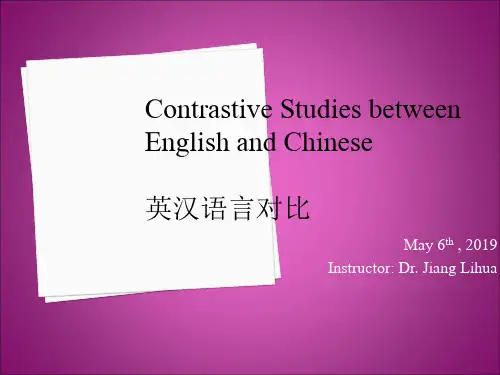

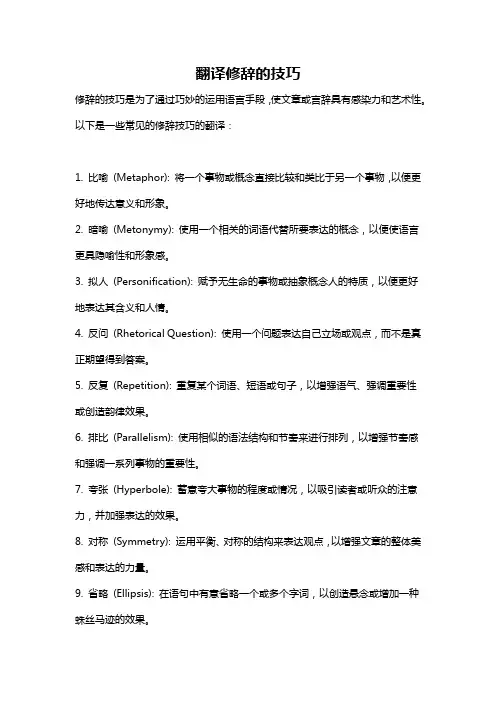
翻译修辞的技巧
修辞的技巧是为了通过巧妙的运用语言手段,使文章或言辞具有感染力和艺术性。
以下是一些常见的修辞技巧的翻译:
1. 比喻(Metaphor): 将一个事物或概念直接比较和类比于另一个事物,以便更好地传达意义和形象。
2. 暗喻(Metonymy): 使用一个相关的词语代替所要表达的概念,以便使语言更具隐喻性和形象感。
3. 拟人(Personification): 赋予无生命的事物或抽象概念人的特质,以便更好地表达其含义和人情。
4. 反问(Rhetorical Question): 使用一个问题表达自己立场或观点,而不是真正期望得到答案。
5. 反复(Repetition): 重复某个词语、短语或句子,以增强语气、强调重要性或创造韵律效果。
6. 排比(Parallelism): 使用相似的语法结构和节奏来进行排列,以增强节奏感和强调一系列事物的重要性。
7. 夸张(Hyperbole): 蓄意夸大事物的程度或情况,以吸引读者或听众的注意力,并加强表达的效果。
8. 对称(Symmetry): 运用平衡、对称的结构来表达观点,以增强文章的整体美感和表达的力量。
9. 省略(Ellipsis): 在语句中有意省略一个或多个字词,以创造悬念或增加一种蛛丝马迹的效果。
10. 比较(Simile): 使用"像"或"如同"等词语,将一个事物直接比较和类比于另一个事物,以增强表达的效果。
以上是一些常见的修辞技巧的翻译,但值得注意的是,修辞是一种艺术性的表达方式,翻译时需要根据上下文和语境进行恰当的转换和运用。

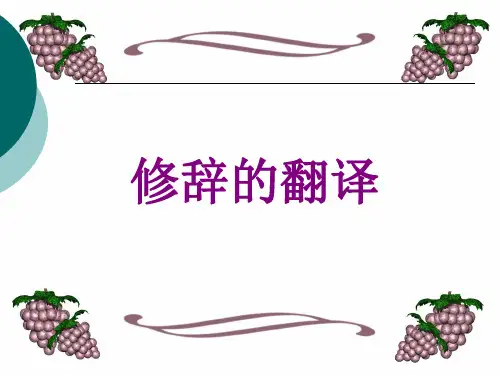
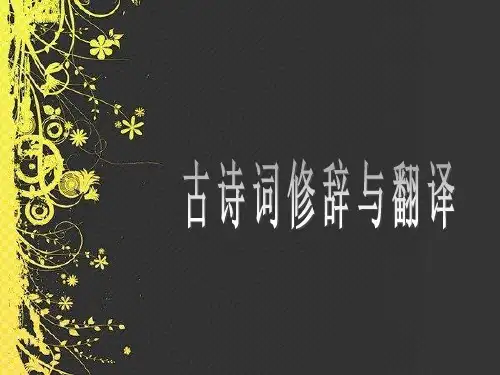
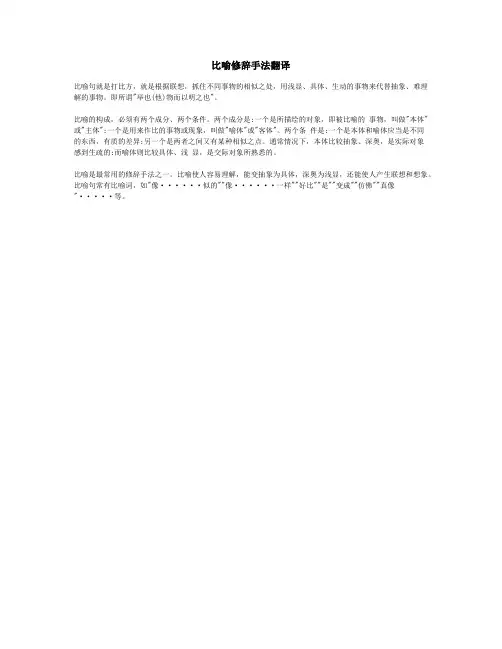
比喻修辞手法翻译
比喻句就是打比方,就是根据联想,抓住不同事物的相似之处,用浅显、具体、生动的事物来代替抽象、难理解的事物。
即所谓"举也(他)物而以明之也"。
比喻的构成,必须有两个成分、两个条件。
两个成分是:一个是所描绘的对象,即被比喻的事物,叫做"本体"或"主体";一个是用来作比的事物或现象,叫做"喻体"或"客体"。
两个条件是:一个是本体和喻体应当是不同
的东西,有质的差异;另一个是两者之间又有某种相似之点。
通常情况下,本体比较抽象、深奥,是实际对象
感到生疏的;而喻体则比较具体、浅显,是交际对象所熟悉的。
比喻是最常用的修辞手法之一。
比喻使人容易理解,能变抽象为具体,深奥为浅显,还能使人产生联想和想象。
比喻句常有比喻词,如"像······似的""像······一样""好比""是""变成""仿佛""真像"·····等。
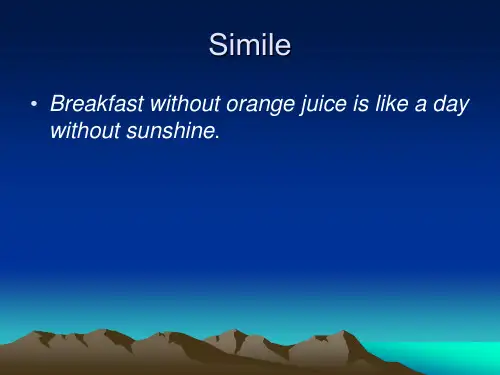

典故修辞手法英语翻译翻译:Allusions Rhetorical device短语英语修辞手法English rhetoric修辞手法题Rhetorical Device Question结构类修辞手法syntactical rhetorical devices例句为了给你的文章润色,你可以更多地使用例如比喻等修辞手法。
To polish up your article, you can use more figures of speech such as metaphors.用修辞手法描述一下这种技术。
Think of this technique in terms of rhetoric.对偶是汉语传统的特有的修辞手法。
Antithesis is a traditional and characteristic rhetoric figure of Chinese language.比喻是诗歌最常见的传统的修辞手法。
Metaphor is traditional rhetoric skill of the most familiar.委婉语是英语中的一个重要的修辞手法。
Euphemism is an important rhetorical device of English.双关修辞手法是广告语写作中的重要手法。
The quibble is an important technique in advertisingwriting.语文不及格?正常!你骂人要用修辞手法吗?Chinese failed? Normal! You call names to use rhetoric?。
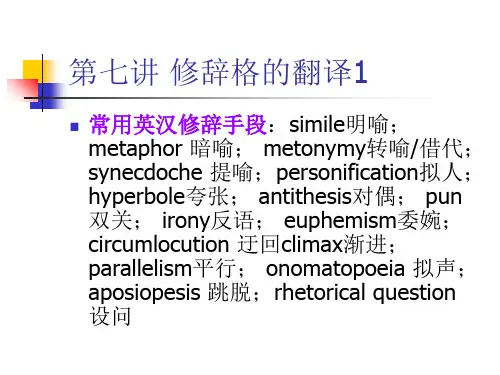

英语修辞手法总结Figures of speech (修辞)are ways of making our language figurative. When we use words in other than their ordinary or literal sense to lend force to an idea, to heighten effect, or to create suggestive imagery, we are said to be speaking or writing figuratively. Now we are going to talk about some common forms of figures of speech.1) Simile:(明喻〕It is a figure of speech which makes a comparison between two unlike elements having at least one quality or characteristic (特性)in common. To make the comparison, words like as, as...as, as if and like are used to transfer the quality we associate with one to the other. For example, As cold waters to a thirsty soul, so is good news from a far country.2) Metaphor:(暗喻〕It is like a simile, also makes a comparison between two unlike elements, but unlike a simile, this comparison is implied rather than stated. For example, the world is a stage.3) Analogy: (类比〕It is also a form of comparison, but unlike simile or metaphor which usually uses comparison on one point of resemblance, analogy draws a parallel between two unlike things that have several common qualities or points of resemblance.4) Personification: (拟人〕It gives human form of feelings to animals, or life and personal attributes(赋予) to inanimate(无生命的) objects, or to ideas and abstractions(抽象). For example, the wind whistled through the trees.5) Hyperbole: (夸大〕 It is the deliberate use of overstatement or exaggeration to achieve emphasis. For instance, he almost died laughing.6) Understatement: (含蓄陈述〕 It is the opposite of hyperbole, or overstatement. It achieves its effect of emphasizing a fact by deliberately(成心地) understating it, impressing the listener or the reader more by what is merely implied or left unsaid than by bare statement. For instance, It is no laughing matter.7) Euphemism: (委婉〕 It is the substitution of an agreeable or inoffensive(无冒犯) expression for one that may offend or suggest something unpleasant. For instance, we refer to "die" as " pass away".8) Metonymy (转喻〕It is a figure of speech that has to do with the substitution of the mane of one thing for that of another. For instance, the pen (words) is mightier than the sword (forces).9) Synecdoche (提喻〕 It is involves the substitution of the part for the whole, or thewhole for the part. For instance, they say there's bread and work for all. She was dressed in silks.10) Antonomasia (换喻〕It has also to do with substitution. It is not often mentioned now, though it is still in frequent use. For example, Solomon for a wise man. Daniel for a wise and fair judge. Judas for a traitor.11) Pun: (双关语〕 It is a play on words, or rather a play on the form and meaning of words. For instance, a cannon-ball took off his legs, so he laid down his arms. (Here "arms" has two meanings: a person's body; weapons carried by a soldier.)12) Syllepsis: (一语双叙〕 It has two connotations.In the first case, it is a figure by which a word, or a particular form or inflection of a word, refers to two or more words in the same sentence, while properly applying to or agreeing with only on of them in grammar or syntax(句法). For example, He addressed you and me, and desired us to follow him. (Here us is used to refer to you and me.)In the second case, it a word may refer to two or more words in the same sentence. For example, while he was fighting , and losing limb and mind, and dying, others stayed behind to pursue education and career. (Here to losingone's limbs in literal; to lose one's mind is figurative, and means to go mad.)13) Zeugma: (轭式搭配〕 It is a single word which is made to modify or to govern two or more words in the same sentence, wither properly applying in sense to only one of them, or applying to them in different senses. For example, The sun shall not burn you by day, nor the moon by night. (Here noon is not strong enough to burn)14) Irony: (反语〕 It is a figure of speech that achieves emphasis by saying the opposite of what is meant, the intended meaning of the words being the oppositeof their usual sense. For instance, we are lucky, what you said makes me feel real good.15) Innuendo: (暗讽〕 It is a mild form of irony, hinting in a rather roundabout (曲折)way at something disparaging(不一致) or uncomplimentary(不赞美) to the person or subject mentioned. For example, the weatherman said it would be worm. He must take his readings in a bathroom.16) Sarcasm: (挖苦〕 It Sarcasm is a strong form of irony. It attacks in a taunting and bitter manner, and its aim is to disparage, ridicule and wound the feelings of the subject attacked. For example, laws are like cobwebs, which may catch small flies, but let wasps break through.17) Paradox: (似非而是的隽语〕 It is a figure of speech consisting of a statementor proposition which on the face of it seems self-contradictory, absurd or contrary to established fact or practice, but which on further thinking and study may prove to be true, well-founded, and even to contain a succinct point. For example more haste, less speed.18) Oxymoron: (矛盾修饰〕 It is a compressed paradox, formed by the conjoining(结合) of two contrasting, contradictory or incongruous(不协调) terms as in bitter-sweet memories, orderly chaos(混乱) and proud humility(侮辱).19) Antithesis: (对照〕 It is the deliberate arrangement of contrasting words or ideas in balanced structural forms to achieve emphasis. For example, speech is silver; silence is golden.20) Epigram: (警句〕 It states a simple truth pithily(有利地) and pungently(强烈地). It is usually terse and arouses interest and surprise by its deep insight into certain aspects of human behavior or feeling. For instance, Few, save the poor, feel for the poor.21) Climax: (渐进〕 It is derived from the Greek word for "ladder" and implies the progression of thought at a uniform or almost uniform rate of significance or intensity, like the steps of a ladder ascending evenly. For example, I came, I saw,I conquered.22) Anti-climax or bathos: (突降〕It is the opposite of Climax. It involves stating one's thoughts in a descending order of significance or intensity, from strong toweak, from weighty to light or frivolous. For instance, But thousands die, without or this or that, die, and endow(赋予) a college, or a cat.23) Apostrophe: (顿呼〕 In this figure of speech, a thing, place, idea or person (dead or absent) is addressed as if present, listening and understanding what is being said. For instance, England! awake! awake! awake!24) Transferred Epithet: (转类形容词〕 It is a figure of speech where an epithet (an adjective or descriptive phrase) is transferred from the noun it should rightly modify(修饰) to another to which it does not really apply or belong. For instance,I spent sleepless nights on my project.25) Alliteration: (头韵〕 It has to do with the sound rather than the sense of words for effect. It is a device that repeats the same sound at frequentintervals(间隔) and since the sound repeated is usually the initial consonant sound, it is also called "front rhyme". For instance, the fair breeze blew, the white foam flew, the furrow followed free.26) Onomatopoeia: (拟声〕 It is a device that uses words which imitate the sounds made by an object (animate or inanimate), or which are associated with or suggestive(提示的) of some action or movementExplanation version1一、什么是修辞格修辞格(figures of speech)是提高语言表达效果的语言艺术。
第十七章修辞的翻译教学目标:了解英语的各种修辞类型,准确理解修辞格的意义;掌握英语修辞格翻译的各种方法教学安排:2课时教学要点:英语修辞格的翻译方法:直译;加注;释义;归化;切分;数种译法并用;英语原文无修辞格,翻译成汉语时用修辞格教学步骤:技巧讲解;现场翻译;小组讨论;教师点评教学内容:附后所谓修辞格,就是为了在读者或听众心目中展现出一副形象生动的画面,使他们能够根据以往的经验产生某种联想,使得比较抽象的事物具体化、简单化而易于接受,而使用某个词的引申含义,以起到修辞效果。
修辞在英语中扮演着很重要的角色,在任何文体中都可以得到应用。
然而,英语修辞格和汉语修辞格有很大的差异,其汉语翻译也就成了学生面临的一大难题。
因此,掌握修辞格及其最佳使用方法,不仅能够帮助我们加深对阅读材料的理解,从而达到准确的翻译与表达,而且还有助于我们更加充分地欣赏作者的写作风格,同时提高我们自己的写作水平。
英语中的修辞格种类繁多,根据其格式是否固定可分为消极修辞和积极修辞两大类。
1. 消极修辞(Passive Rhetoric Techniques)2. 积极修辞格(Active Rhetoric Techniques)2.1 明喻(Simile) 2.2 暗喻(Metaphor)2.3 引喻(Allusion) 2.4 讽喻(Allegory)2.5 提喻(Synecdoche) 2.6 转喻(Metonymy)2.7 拟人(Personification) 2.8 拟物(Plantification)2.9 反语(Irony) 2.10 夸张(Hyperbole)2.11 矛盾修辞法(Oxymoron) 2.13 拟声(Onomatopoeia)一、消极修辞(Passive Rhetoric Techniques)消极修辞主要指那些没有相对固定格式的修辞性写作技巧。
它与语法、语言结构和词汇的关系密切,只是为了修辞和立意新颖的缘故,对之做了一些调整。
譬如:为了增加文采,强化文章的表现力,常常避免重复使用同一词汇,而另选他词。
这种无固定格式可循的消极修辞手法被称为“求雅换词”(Elegant Variation )。
如在Elizabeth Razzi 写的题为“10 Ways to Lose Pounds”(十种减肥方法)的文章中,“减肥”的表达竟有8 种,文笔活泼,文采灿然:1. Try to shed a few extra pounds.2. Studies show these efforts may shave off the pounds quickly.3. Here are ten simple strategies that can help melt away your fat forever.4. … like a logical way to peel off a few pounds.5. … roughly the amount needed to burn off one pound.6. You must eat less to lose weight.7. A key obstacle to dropping extra pounds is after-dinner snacking.8. 10 Ways to Lose Pounds.以上8 句中的划线部分让我们欣赏了英语词汇的活力与风采。
(一)求雅换词的手法之一是大词小用或小词大用。
1) Don’t take the low-fat label as a license to eat.不能因为食品标明低脂肪而敞开食用。
这个句子的精彩之处在于“license”一词。
它是用途很广的大词,意为“执照”、“许可证”等。
用在这里给人一种“头小帽大”的感觉,新颖别致。
译文却很难保留这种表达效果。
2) If the term sounds unscientific to 20th-century ears, let us remember there is a definiteconnection between marshy lands and malaria…如果这个术语对生活在20 世纪的人听来不科学的话,那就让我们记住沼泽地和疟疾之间是有一定联系的……。
其中“ear”一词使用范围极小,只是表示人的听力器官——耳朵,但在此处却将它的所指范围扩大,给人一种焕然一新的感觉。
(二)求雅换词的手法之二是科技词汇和日常用语的“错位”。
1) Nave rats and frogs are said to have reacted wildly to such proposed experimentedsituation.据说,首次用来作实验的鼠和蛙对这种设定的环境改变都有剧烈反应。
“Nave”用于现代生物学时的含义为:not previously subjected to experimentation or particular experimented situation.2) However, there are plenty of people who like tennis. It is the megagame.但是许许多多的人喜欢网球,这是一项十分普及的运动。
“Mega”的含义是兆、百万,是一个科技英语的词缀,用在这里新义顿生。
二、积极修辞格(Active Rhetoric Techniques)积极修辞格主要指那些有相对固定格式的修辞性写作技巧。
常见分类如下:(一)明喻(Simile)明喻是把两种具有相同特征的事物和现象进行对比,表明本体和喻体之间的相似关系,两者都在对比中出现。
常用比喻词有like, as if, as, as though 等。
1) The cheque fluttered to the floor like a bird with a broken wing.支票像一只断了翅膀的小鸟似地飘落到地板上。
2) He looked at me with an air of surprised disapproval, as a colonel might look at a privatewhose bootlaces were undone.他带着一种吃惊的、不以为然的神态看着我,犹如一位上校看着一名没有系好靴带的二等兵一样。
(二)暗喻(Metaphor)暗喻也叫隐喻。
这种比喻不通过比喻词进行,而是直接将甲事物当作乙事物来描写,甲乙两事物之间的联系和相似之处是暗含的。
Webs ter’s New Wo rld Dictionary 给暗喻下的定义是“a figure of speech containing an implied comparison, in which a word or phrase ordinarily and primarily used of one thing is applied to another”(一种隐含着比喻的修辞格,它通常和基本的用法是表述某一事物的词或者词组被用来比喻另外的一种事物),这个解释简洁明了,暗喻中的主体与喻体的关系比明喻更为紧密。
因此,《辞海》说“明喻在形式上只是相类的关系,暗喻在形式上却是相合的关系”。
在形式上,暗喻已不用like, as 等比喻词了。
1) There were no more butterflies in my stomach when I opened up an abdomen or a chest.当我切开病人的腹部和胸腔时,我不再紧张得瑟瑟发抖了。
本句只有喻体“butterflies”(蝴蝶),没有本体和比喻词。
“butterflies in my stomach”暗喻“紧张颤抖”。
2) What will parents do without the electronic baby-sitter如果少了这位电子保姆,做父母的可怎么办呢?句中本体“TV”并未出现,只有喻体“the electronic baby-sitter”,把电视暗喻为电子保姆,因为电视和保姆都可以起到为父母照看小孩的作用。
(三)引喻(Allusion)引喻就是引用人们熟知的出自神话、寓言、宗教、民俗、格言、成语、文学名著等带有典故性的词语,构成联想,比喻要说明的人或事。
它的特点是不注明出处,一般只引用关键词或词组,正如Webs ter’s N ew World Dictionary 所说,引喻是“an indirect reference; casual mention”,它与叙述或论说融为一体。
适当运用引喻可以做到事出有典,言之有据,使语言的表达变得非常简洁、凝练、精辟、生动,从而增强说服力与感染力。
1) Being a teacher is being present at the creation, when the clay begins to breathe.当一名教师意味着是创造的见证人,他目睹人体开始呼吸,开始了生命。
句中creation(创造)、clay(黏土)、breathe(呼吸)的典故出自《圣经》(The Bible)。
根据《圣经》,人是上帝用黏土创造出来的,当上帝将气息灌入黏土人体,人们开始了呼吸,开始了生命。
作者引用这个典故是想说明,父母给了学生以肉体,教师帮助学生塑造灵魂和人格。
(四)讽喻(Allegory)讽喻是通过具体形象来表示抽象概念,用形象来说明一些深刻的道理。
讽喻有时表现在整篇作品中,作品中任务、行为、情节多暗示与之相似的人物、事件、观念、道德等,弦外之音强烈,多以故事来训诲与启发,寓言就是其中的一种。
如《伊索寓言》中的“狐狸与葡萄”,狐狸几次蹦跳都未吃到葡萄,临走时说“葡萄是酸的”,寓意嘲讽那种奋力追求某种事物几经失败后而极力贬低某种事物的无可奈何的心境。
1) You can lead a horse to water, but you can’t make him drink.引马河边易,逼马喝水难。
指:A teacher can make some good suggestions to his students, but he can’t force correct understanding and usage on them.(五)提喻(Synecdoche)提喻是指在同性质、同种类、同一体的事物中,大小互代、部分和整体互代、抽象和具体互代、原料代替所构成的成品等,反之亦然。
Webs ter’s New World Dictionary 给提喻下的定义是“a figure of s peech in which a part is used for a whole, an individual for a class, a material for a thing, or the reverse of any of these”.(六)转喻(Metonymy)转喻又称借代。